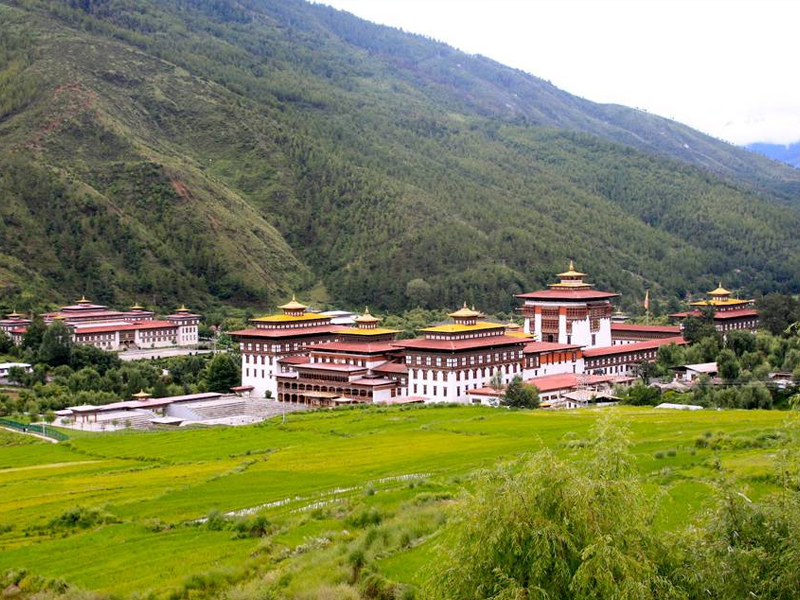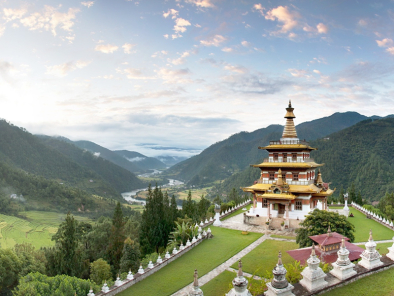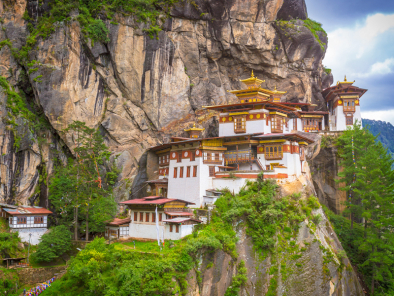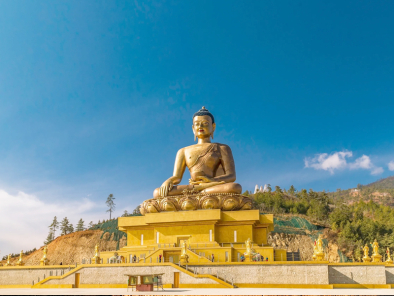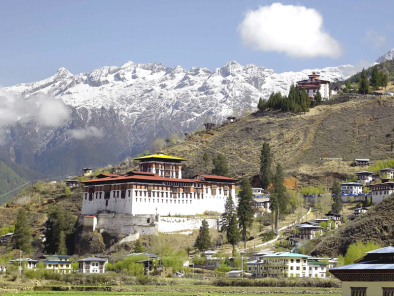The flight to Paro is one of the most spectacular in entire Himalayas. Flying along the Himalayan range from Kathmandu, the journey offers fascinating views and an exciting descent into the Kingdom. Bhutan’s first gift to you as you disembark from the aircraft will be cool, clean fresh and virgin mountain air. After immigration formalities and baggage collection, you will be met by our representative outside the exit gate, and afterwards drive to Thimphu, the capital town of Bhutan.
On arrival, in Thimphu check-into the hotel. The capital town of Bhutan and the centre of government, religion and commerce, Thimphu is a unique city with unusual mixture of modern development alongside ancient traditions. With the population of about 90,000 it is perhaps still the world’s only capital city without a traffic light.
Later in the day take an exploratory walk around Thimphu Craft Bazaar located a few minutes walk from down town hotels. This market offers genuine Bhutanese arts & crafts thus contributing in promotion, protection and preservation of traditional arts.
Overnight at the hotel in Thimphu.
-
-

- Dinner
Included
-

After breakfast, we will take a tour of Thimphu City. We will visit the following sites:
Folk Heritage Museum The museum gives you a glimpse of the traditional Bhutanese lifestyle, in addition to artifacts from rural households; it also displays an impressive collection of typical household objects, tools and equipment.
Zorig Chusum (the 'Painting School') - The Institute of Zorig Chusum in Thimphu is the premier institution of traditional arts and crafts set up by the Government of Bhutan with the sole objective of preserving the rich culture and tradition of Bhutan and training students in all traditional art forms.
Thangtong Dewachen Nunnery (Zilukha Nunnery) - The nunnery is located in Zilukha (Thimphu District) overlooking Tashichodzong and is a few minutes’ drive from the town, it is popularly known as the Zilukha Anim Dratshang. It was built in 1976 by the 16th emanation of Thangtong Gyalpo, Drubthob Rikey Jadrel. Currently, the nunnery is home to about 60 nuns.
We will then stop at a local restaurant for lunch. In the afternoon we will visit the following:
Memorial Chorten - a Stupa built in 1974 to honor the third King, Jigme Dorji Wangchuck. This large chorten is one of the most visible landmarks in Thimphu, and for many Bhutanese it is the focus of daily worship. Elderly people shuffle meditatively around the chorten, families light butter lamps, and kids rush out a quick parikrama (ritual circumambulation).
Gagyel Lhundrup Weaving Centre - This private weaving centre at the south end of Thimphu produces expensive but high-quality hand-woven textiles and has a selection of ready-made garments for sale (scarves, belts, jackets, shawls and kira). You can watch weavers at work and photos are allowed.
Jungshi Paper factory - This small factory produces traditional Bhutanese paper handmade from the bark of the daphne bush. You can see the whole process, from soaking and boiling the bark to sorting, crushing, pulping, layering, pressing and drying. Products for sale here include lovely decorated paper with embedded leaves and even dried chillis, plus cards, notebooks, lampshades and calendars.
Tashichho Dzong - In the evening visit, Fortress of the Glorious Religion. This impressive fortress houses some ministries, His Majesty’s secretariat, and the central monk body.
Return to your hotel and the evening is at leisure.
Dinner at hotel
Overnight at hotel
Included Meals: Breakfast and Dinner
-
-

- Breakfast
Included
-
-

- Dinner
Included

-
-

- Breakfast
Included
-
-

- Dinner
Included

A visit to a traditional Bhutanese village can be arranged so that guests can view life in rural Bhutan. For those desiring more energetic pursuits – hiking to nearby villages can be arranged.
Today you will visit the Sangchhen Dorji Lhuendrup nunnery - The nunnery is perched on a ridge amid pine trees overlooking Punakha and Wangduephodrang. The temple complex houses a permanent learning and meditation centre for nuns where apart from religious training, it provides skill training such as tailoring, embroidery, statue making and thangka painting. Continue your drive to Talo Monastery: The site was founded by Chogtrul Jigme Singye (1742-89), the 4th reincarnation of Lama Thripa (Galsey Tenzin Rabgye), which literally means the holder of the throne, a title given to Gyalsay Tenzin Rabgye (1638-96) as the Gyaltsap (regent) appointed by Zhabdrung Ngawang Namgyel. This took place in 1767 corresponding to the 13th Rabjung (name of the cycle of 60 years starting with rabbit year) of the Fire Pig Year of the Bhutanese calendar.
Khamsum Yuley Namgay Chorten was built in 1990s and took period of nearly 10 years. It was built by Queen Mother and dedicated to the King and for the well being of Bhutanese. It majestically located on a ridge, with amazing views of the country side. It is one of the finest Bhutanese architects. It is located in idyllic countryside north of Punakha, about 30 minutes drive from town. From the parking, it is another 45 minutes uphill walk through the rice fields and the return portion downhill takes around 30 minutes. In the summer or during the rainfall, the trails could be muddy and slippery. After return walk back, there is an option to walk along the riverside, following the ancient trail that goes through farmlands, homes, Sonagasa village and arrive near Punakha Dzong. This extra walk takes another two hours or so. It is particularly interesting for those interested in birding and to enjoy the walk viewing the countryside.
-
-

- Breakfast
Included
-
-

- Dinner
Included

-
-

- Breakfast
Included
-
-

- Dinner
Included
The Tiger's Nest Monastery is built on the where guru Padmasambhava is reputed to have flown to on the back of a Tiger. The monastery is a revered site for the Bhutanese. The walk up to the viewpoint takes roughly two hours and is an uphill climb through alpine forests. LUNCH on the trail or can be eaten at the cafeteria, which provides a good view of the monastery. The monastery was partially destroyed in a forest though restoration works are almost complete. The local people have provided the labour for restoration. Bhutanese believe that participating in the restoration of holy places helps in the accumulation of good merit.
Your guide will also take you to the lesser know sites - Dumtse Lhakhang; this unusual building was built in 1433 by the iron bridge builder Thangtong Gyalpo. It has three floors representing hell, earth, heaven and the paintings inside are said to be some of the best in Bhutan. Kyichu Lhakhang: It is one of the oldest monasteries in the country built in the 7th century by the Tibetan King Songsten Gampo. The story goes that a giant demoness lay across the whole area of Tibet and the Himalayas and was preventing the spread of Buddhism.
Drive back to the hotel after the hike and relax for rest of the day as you will be tired after the hike to the Tiger’s nest or make a Spa appointment.
-
-

- Breakfast
Included
-
-

- Dinner
Included
After breakfast, drive to the airport for flight to your onward destination. Our representative will see you off and then bid you farewell.
-
-

- Breakfast
Included
-
Inclusions International
- GST 5% on Total Cost of Package
- 5% TCS (Tax Collection at Source) is applicable for all payments from 1st Oct, 2020, applicable on total invoice value
- City Tax Payable Directly at Hotel At the Time of Checkout
- Visa Fee
- Air Ticket
- Medical / Travel Insurance
- Super peak season surcharge in hotels or weekends surcharges(if any)
- Any item of personal nature viz telephone, beverages , laundry , tips gratuities etc
- Any other services that is not shown/ mentioned in the list of inclusion above
- Meals and sightseeing other than above
- For Air Tickets Support Services
- Presently most of the Airline need the Passenger to do the web Check in Before check in Air Airport , Passenger Can Do the Web Check in at Own Level at Airline Web Site and Take the Boarding Pass , Web Check in offer
- * Select the Seats Preferred ( Some Seats Attract Charges Payable to Airlines )
- * Meals Preferred ( If No Meal is Booked Advance Preferred Meals Cannot be Guaranteed)
- * Print Boarding Passes
- Regency Tours offer Services (other Actual Charges Payable Extra )
- Web Check In Domestic Rs 200 Per Person Per Sector
- International Rs 300 Per Person Per Sector
- Meals Meals Cost As per Airline if Any ( No Extra Charges)
- International Travelling Air Suvidha Rs 500 Per Person
- Travel Pass Rs 500 Per Person Per Country
- RT PCR/Covid Test Support fee Rs 500 Per Person Per Country
- Medical / Travel Insurance As Per Actual Cost of Policy
- Ticket Reissue/refund Domestic Rs 300 Per Sector
- International Rs 500 Per Sector
- Guests if Not Vaccinated :-need to carry a Covid-19 RT-PCR negative test report sample given within 96 hrs of arrival dat
- Kindly carry few copies of your Covid Report and Photo ID for convenience
- The above is only a quotation and we are not holding any confirmed reservation/services at the moment.
- The above quote is valid for a period of 3 days starting today.
- Any amendments in the dates of travel or number of passengers will attract a re-quote.
- Prices are subject to change unless booked and paid for in advance.
- Rates for arrival and departure transfers and coach tours are based on all passengers travelling together in one vehicle with all passengers arriving/departing together (in the same flight). Airport transfer rates are not valid in case passengers are arriving / departing on different flights. Any change in Pax numbers will result in change in rates.
- Rooms will be subject to availability at the time of confirming the reservation.
- Kindly note that driver will wait at the arrivals for a maximum of 120 minutes after the flight arrives.
- PAN Card and Passport Copies are mandatory of all the Passengers.
- Prices are valid for stated travel period and are of defined validity, any change in the dates will lead to re-costing.
- For the above said tour, there is no pick up and drop off from the hotel (unless specified), so client will have to reach at departure points and back to hotel also at their own arrangement
- All train tickets are subject to price at the time of issuance. Price May fluctuate for train tickets, exact price to be considered at the time of issuance
- The Guests will have to manage on their own till the Pickup / Drop off point for SIC TOURS
- All above costs are quoted per person in Indian Rupees. In the event if there is any fluctuation of USD rate against Indian Rupees (INR) or any extreme changes of unforeseen economical fluctuation, we will have to re-quoted the prices accordingly
- All above rates are quoted and valid for min 03 pax. In any event the number of participant is less than that number, we have right to re-visit and re-quote accordingly.
- Price quoted based on lowest room category.
- The Hotel Standard Check In time 1400hrs and Check out time 1200hrs.
- Early check in will be considered as 01 night stay. Free early check in is based on request and availability.
- Late check-out is based on request and availability only.
- No room, flight booking has been blocked and no land arrangement has been made yet. Room confirmation & bedding type is subject to availability upon booking is made. if the same property is not available will advise you similar category, in case there is a variation in hotels / room category difference will be supplement.
- **Airport / Hotel / Station Transfers Between 2100hrs and 0500hrs will lead to Extra Night surcharges&hellipwhich has to be paid extra apart from above cost
- Above rates are Nett and Non-commissionable.
- All tours are subject to Regency Tours Pvt. Ltd tour conditions.
NOTE:
- No Cash Deposite if Allowed in Bank Account, Only Payment Modes are NEFT, RTGS, Chq,G Pay, Paytm, Credit Card ( Bank Charges Apply)
- As per Govt Norms 5% TCS will be Applicable for on Outward Remittance ( PAN Card Mandatory for All Outbound Bookings)
- As per RBI guidelines it is mandatory to provide Pan card of the traveller.
- Henceforth bookings will be processed only upon receipt of pan card photocopy
- Prices are valid for stated travel period and are of defined validity, any change in the dates will lead to re-costing.
- Any cancellation of rooms must be notified in writing 7 working days before group arrival and you must ensure you receive our acknowledgment in order to avoid cancellation charge imposed by hotel to you. Different cancellation deadlines may apply to public holidays, Christmas, New Year, Chinese New Year, individual hotel & peak periods, special events, fairs, conferences and convention periods.
- During individual hotels ,peak periods, special events, fairs, conferences and conventions, rooms held must be washed down according to the hotel policy. Otherwise unused rooms will be charged accordingly by hotel to you.
- Certain sightseeing and day tours may be subject to weather conditions or minimum number of pax before they operate and suppliers may cancel of postpone the date of the tour at short notice. Any changes shall be notified to you at the earliest opportunity.
- There is no refund for services not utilized. Extra note for private transfers services,
- Closer to date bookings will attract 100% cancellation.
- Guests if Not Vaccinated :-need to carry a Covid-19 RT-PCR negative test report sample given within 96 hrs of arrival date
- Kindly carry few copies of your Covid Report and Photo ID for convenience
- Regency Tours will not be resposible for any Information and Changes in th Covid Restriction Imposed by Any Govt / Authorities
- Prepare a day-to-day itinerary
- Check your passport expiry date
- Print your tickets and insurance
- Carry you photo ID proof and a copy
- Check-in online for your flight
- Buy an international SIM card or activate international roaming
- If you are going to drive in another country, get an international license.
- Mail yourself the soft copies of all important s.
- Prepare a list of emergency phone numbers and carry in your wallet.
- Research a bit about the Indian Embassy and its location in the country you are visiting in case you need it during a natural or man-made disaster.
- We have Weekend Packages as well as Honeymoon & Family Packages not only this we are provide value for money deals to our corporate for incentive movements You enjoy each place in an unrushed style desire, feel and have the time of your life because we always believe in providing you the best.
Refund Policy
